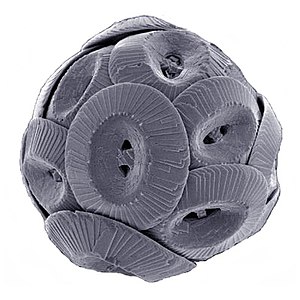합티스타
합티스타(Haptista)는 제안된 원생생물 분류군의 하나로 육질태양충류와 착편모조류 등으로 이루어져 있다. 계통유전체학 연구 결과 SAR 상군과 자매군을 형성하는 것으로 추정된다.[1][2]
|
| ||
|---|---|---|
 | ||
| 생물 분류ℹ️ | ||
| 역: | 진핵생물 | |
| (미분류): | 식물+HC+SAR 대형군 | |
| (미분류): | 하크로비아 | |
| (미분류): | 합티스타 (Haptista) Cavalier-Smith 2015 | |
| 아문 | ||
|
| ||
하위 분류
편집캐빌리어-스미스(Cavalier-Smith), 차오와 루이스(Chao & Lewis 2015)[3], 루지에로 등(Ruggiero et al. 2015)[4]의 연구에 기초한 하위 분류는 다음과 같다.
- 알베이다아문 (Alveidia) Cavalier-Smith 2018
- 알베이다강 (Alveidea) Cavalier-Smith 2018[5]
- 알베이다목 (Alveida)
- 앙코라키스타 트위스타 (Ancoracysta twista)[5]
- 알베이다목 (Alveida)
- 알베이다강 (Alveidea) Cavalier-Smith 2018[5]
- 육질태양충아문 (Centroheliozoa) Cushman & Jarvis 1929 sensu Durrschmidt & Patterson 1987 [Heliozoa Haeckel 1862 stat. n. Margulis 1974 em. Cavalier-Smith 2003]
- 육질태양충강 (Centrohelea) Kuhn 1926 stat. n. Cavalier-Smith 1993 [Centroplastiales; Centrohelina Hartmann 1913; Centroplasthelida Febvre-Chevalier 1984]
- 착편모조아문 (Haptophytina) Cavalier-Smith 2015 (Haptophyta Hibberd 1976 sensu Ruggerio et al. 2015)
- Rappemonada Kim et al. 2011
- Rappephyceae Cavalier-Smith 2015
- 착편모조강 (Haptomonada) (Margulis & Schwartz 1998) [Haptophyta Hibberd 1976 emend. Edvardsen & Eikrem 2000; Prymnesiophyta Green & Jordan, 1994; Prymnesiomonada; Prymnesiida Hibberd 1976; Haptophyceae Christensen 1962 ex Silva 1980; Haptomonadida; Patelliferea Cavalier-Smith 1993]
- Rappemonada Kim et al. 2011
계통 분류
편집다음에 제안된 계통발생에는 엑스카바타 생물군 중 단 하나의 그룹(디스코바)만 포함되어 있으며[6] 피코조아가 홍조식물의 가까운 친척이라는 2021년 제안이 포함되어 있다.[7] 프로보라는 2022년에 발견된 미생물 포식자 집단이다.[8] 메타모나다는 아마도 디스코바, 아마도 말라이모나스문의 자매일 가능성이 있어 배치하기 어렵다.[9][10][11]
| 진핵생물 |
| ||||||||||||||||||||||||||||||||||||||||||||||||||||||||||||||||||||||||||||||||||||||||||||||||||||||||||||||||||||||||||||||||||||
| 22억 년 전? |
2016년 실라(Silar)에 의한 하크로비아의 계통 분류는 다음과 같다.[12][13]
| 하크로비아 |
| ||||||||||||||||||||||||||||||||||||||||||||||||||||||||||||
각주
편집- ↑ Burki F,; Kaplan M,; Tikhonenkov DV,; Zlatogursky V,; Minh BQ,; Radaykina LV,; Smirnov A,; Mylnikov AP,; Keeling PJ (2016), “Untangling the early diversification of eukaryotes: a phylogenomic study of the evolutionary origins of Centrohelida, Haptophyta and Cryptista.”, 《Proc Biol Sci》 283 (1823): 20152802, doi:10.1098/rspb.2015.2802, PMC 4795036, PMID 26817772
- ↑ Burki, F; Inagaki, Y; Bråte, J; Archibald, J.; Keeling, P.; Cavalier-Smith, T; Sakaguchi, M; Hashimoto, T; Horak, A; Kumar, S; Klaveness, D; Jakobsen, K.S; Pawlowski, J; Shalchian-Tabrizi, K (2009). “Large-scale phylogenomic analyses reveal that two enigmatic protist lineages, Telonemia and Centroheliozoa, are related to photosynthetic chromalveolates.”. 《Genome Biology and Evolution》 1: 231–8. doi:10.1093/gbe/evp022. PMC 2817417. PMID 20333193. 2012년 7월 10일에 원본 문서 (Free full text)에서 보존된 문서.
- ↑ Cavalier-Smith; Chao; Lewis (2015), “Multiple origins of Heliozoa from flagellate ancestors: New cryptist subphylum Corbihelia, superclass Corbistoma, and monophyly of Haptista, Cryptista, Hacrobia and Chromista”, 《Molecular Phylogenetics and Evolution》 93: 331–362, doi:10.1016/j.ympev.2015.07.004, PMID 26234272
- ↑ Ruggiero; 외. (2015), “Higher Level Classification of All Living Organisms”, 《PLoS ONE》 10 (4): e0119248, doi:10.1371/journal.pone.0119248, PMC 4418965, PMID 25923521
- ↑ 가 나 Cavalier-Smith, T.; Chao, E. E.; Lewis, R. (2018년 4월 17일). “Multigene phylogeny and cell evolution of chromist infrakingdom Rhizaria: contrasting cell organisation of sister phyla Cercozoa and Retaria”. 《Protoplasma》 255 (5): 1517–1574. doi:10.1007/s00709-018-1241-1. PMC 6133090. PMID 29666938.
- ↑ Brown, Matthew W.; Heiss, Aaron A.; Kamikawa, Ryoma; Inagaki, Yuji; Yabuki, Akinori; Tice, Alexander K; Shiratori, Takashi; Ishida, Ken-Ichiro; Hashimoto, Tetsuo; Simpson, Alastair; Roger, Andrew (2018년 1월 19일). “Phylogenomics Places Orphan Protistan Lineages in a Novel Eukaryotic Super-Group”. 《Genome Biology and Evolution》 10 (2): 427–433. doi:10.1093/gbe/evy014. PMC 5793813. PMID 29360967.
- ↑ Schön ME; Zlatogursky VV; Singh RP; 외. (2021). “Picozoa are archaeplastids without plastid”. 《Nature Communications》 12 (1): 6651. doi:10.1038/s41467-021-26918-0. PMC 8599508. PMID 34789758.
- ↑ Tikhonenkov DV; Mikhailov KV; Gawryluk RM; Belyaev AO; Mathur V; Karpov SA; Zagumyonnyi DG; Borodina AS; Prokina KI; Mylnikov AP; Aleoshin VV; Keeling PJ (2022년 12월). “Microbial predators form a new supergroup of eukaryotes”. 《네이쳐》 612 (7941): 714–719. Bibcode:2022Natur.612..714T. doi:10.1038/s41586-022-05511-5. PMID 36477531. S2CID 254436650.
- ↑ Burki F (2014년 5월). “전 지구적인 계통발생학적 관점에서 본 진핵생물의 생명나무”. 《Cold Spring Harbor Perspectives in Biology》 6 (5): a016147. doi:10.1101/cshperspect.a016147. PMC 3996474. PMID 24789819.
- ↑ Burki, Fabien; Kaplan, Maia; Tikhonenkov, Denis V.; Zlatogursky, Vasily; Minh, Bui Quang; Radaykina, Liudmila V.; Smirnov, Alexey; Mylnikov, Alexander P.; Keeling, Patrick J. (2016년 1월 27일). “Untangling the early diversification of eukaryotes: a phylogenomic study of the evolutionary origins of Centrohelida, Haptophyta and Cryptista”. 《Proc. R. Soc. B》 283 (1823): 20152802. doi:10.1098/rspb.2015.2802. PMC 4795036. PMID 26817772.
- ↑ Karnkowska, Anna; Vacek, Vojtěch; Zubáčová, Zuzana; Treitli, Sebastian C.; Petrželková, Romana; Eme, Laura; Novák, Lukáš; Žárský, Vojtěch; Barlow, Lael D. (2016). “A Eukaryote without a Mitochondrial Organelle”. 《Current Biology》 26 (10): 1274–1284. doi:10.1016/j.cub.2016.03.053.
- ↑ Silar, Philippe (2016), “Protistes Eucaryotes: Origine, Evolution et Biologie des Microbes Eucaryotes”, 《HAL archives-ouvertes》: 1–462
- ↑ Ruggiero; 외. (2015), “Higher Level Classification of All Living Organisms”, 《PLoS ONE》 10 (4): e0119248, doi:10.1371/journal.pone.0119248, PMC 4418965, PMID 25923521